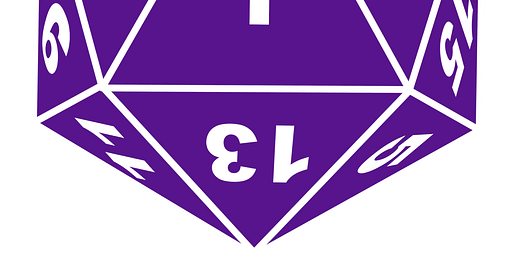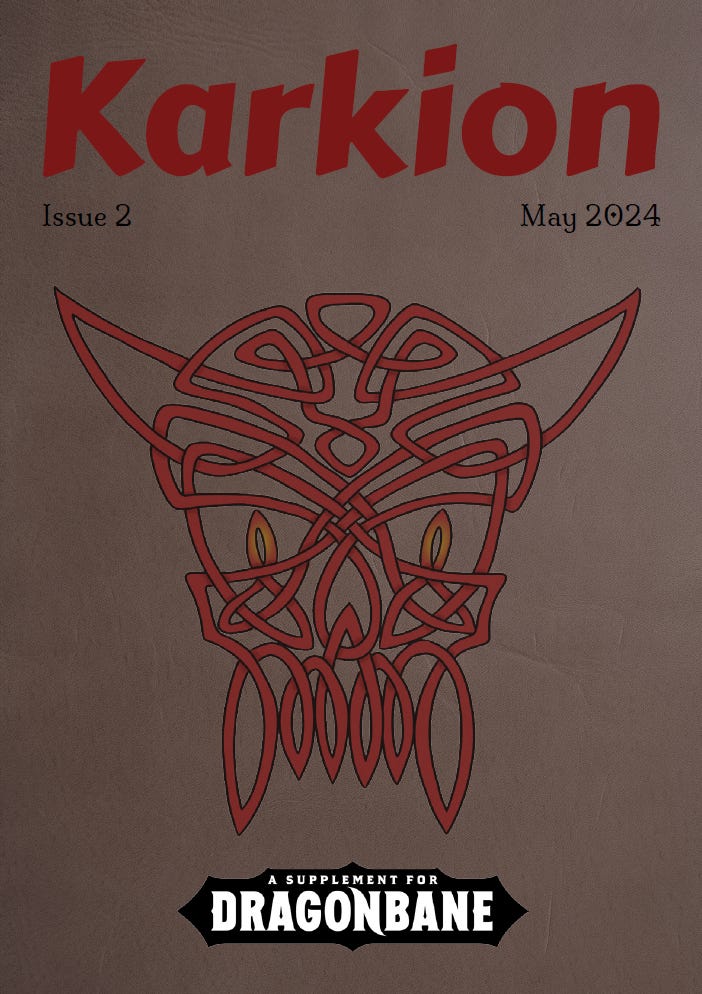Welcome to our community newsletter!
Here's what we've got for you today:
“Make a game with me” week 6 means…playtest time…right?
The new special series, Accounts of Adventure, continues with part 2 of “An Ale to Kill For” from Karkion #2.
Schlau’s free map is space-themed.
My friend Warren Davidson - or Wazza as many RPG players know him - returns as a special guest writer. He is a wealth of information regarding all things ttRPG.
(Tipping my cowgirl hat) Howdy y’all. I’m K.J. If you’d like to learn more about me, click that lil’ green button below.
“Make a game with me” - Week 6
The series where I make a game with you the audience.
Me, talking to my lil’ game:
Status Update for Week 6:
Self Aware is entering playtest mode. While I don’t have any results to share with you just yet, I do have the roll tables that I’ll be using to playtest.
Here’s a brief preview of some of the roll tables I’ll use for playtesting (the * notations will make more sense when I explain the first round of playtest results next week):
What do you think? Is there anything I should add or change?
Are there better descriptors I should use? Are there other obstacles I should add? Is there anything you think I should change?
How to participate in the “make a game with me” series:
Click on the “Leave a comment” and share your thoughts to help me create this RPG. All participants get credited in the final (free) product.
Accounts of Adventure: “An Ale to Kill For” - Part 2
I ran “An Ale to Kill For”- the adventure written by Tomas Brattström found in Karkion #2 - a Dragonbane fanzine and supplement created by Nicklas Brandin, Tomas Brattström, and Thomas Ulfström.
SPOILERS AHEAD:
**Do not read if you plan to play “An Ale to Kill For” anytime soon.**
Scroll down past the buttons to read the game report.
These supplements are available on DriveThruRPG and are in Swedish and English.
And now, the rest of the RPG session…
After sampling Ulrik’s tasty ale, Schlau slips into a back storage area of the brewery and discovers that Ulrik has a couple of vials filled with the mysterious blue liquid identical to the ones he and the other party members discovered earlier at the lake. The boastful ale-maker had told the adventurers his version of how the vials were connected to the yellow pollen and a wizard named Litorik.* He also brags continually about how his superior drink has kept him healthy - unlike the rest of Skyndale.
*Side note: Ulrik knows more than he reveals here, but he keeps that bit of information to himself out of self-preservation.
The party decides they want to know more about the wizard, so they go down the street to visit this supposedly powerful magic-user in his modern, up-scale mansion.

No one is home, so to Schlau and Feather this means they can investigate unhindered by…occupants. What they learn gives them the ability to confront Litorik about the truth and have a chance at saving the village.
Before they do that, however, they’ll have to rescue said wizard. No problem - except where the devil is Litorik?
They travel about the area, discovering not only the real source of the yellow pollen and what kind of liquid is in the vials, they also meet an interesting kin (created just for Karkion Issue #2) - Stonefolk.

After recruiting some additional help, Schlau and Feather work hard to negotiate for the wizard’s freedom. This occurs in the form of a dual between Schlau and Gumba the Stonefolk leader. There were so many terrible rolls on both sides of the GM screen, causing a lot of missed hits on both sides. (It was an incredible and funny moment at our game table.) Finally, the mighty Gumba lands what appears to be a fatal, boulder-packed blow to Schlau’s slender, human frame, causing the player to need to begin his series of death rolls. In a fantastic twist, he rolled a dragon on his first death roll.*
*In Dragonbane, rolling a 1 on the D20 is called a dragon - and this is a success! If you roll a dragon when making a death roll, it counts as two successful death rolls. You need three successful death rolls total to survive, and these are rolled against your Constitution. (For further reference, a 20 on a D20 is a demon - and this is failure.)

Gumba is poised and ready to finish off his opponent, but Schlau comes back with a vengence, ultimately humiliating the proud leader with a significant amount of damage. The threat of the village being plundered by the Stonefolk now neutralized, and with the other party member’s assistance, the young mage is able to rescue Litorik. From there, they also ensure that the yellow pollen never becomes an issue for Skyndale again and - thanks to Litorik permanently converting his mansion into a hospital - all the villagers are made well again.
Need Some Space? Enjoy Schlau’s Free Map!
Here is a creative bridge over acid, icy cold, and lava in either a space background for SciFi/ Arcane settings or PNG transparent background for more customized and universal use. Though gridless, each central panel is 3 squares long by 1 wide.
Wazza’s Whimsical Wanderings Part One – Up and Running
by guest writer Warren Davidson
Let’s start with a list and see how many you recognise: DM, Facilitator, GM, Judge, Keeper, Moderator, Referee and Storyteller. Though there are plenty more, I’m familiar with these. Guess what? They’re all the same thing, fancy names for the person who takes up the mantle of running a role-playing game. It’s a daunting prospect, don’t let anyone kid you and overwhelming at first, with so much advice out there (including yours truly) including live streams with amazing production values, countless hours of online blogs and vlogs telling you how to run a game and rules interpretations. This is meant to be fun right, so how come there’s so much work involved? I don’t pretend to know everything and have all the answers, what I can do is give you the benefit of my forty years of experience and some helpful hints and tips. Oh, and don’t worry running a role-playing game is one of the most rewarding experiences you can ever have. So, let’s dive on in!
When I started out in the early 1980s there was no online tutorials, Virtual Table Tops or live streams, there wasn’t even an internet! It’s almost impossible to image a world without it but there you are, and I ran some of my best games in those years and look back now with fond memories. I had a handful of Advanced Dungeons & Dragons books (1st Edition of course), an A4 pad of lined paper, pencils, erasers and low-quality dice (from the 1983 D&D basic set, where you had to fill in the numbers with a blue crayon!). I picked up a copy of “Dungeon Module I1: Dwellers of the Forbidden City” by David Cook from my local game store and ran it. Well, I tried too! Back in those days the Player’s Handbook and Dungeon Master’s guide might as well have been written in Swahili, crammed full of random tables, and attack matrixes. I didn’t have a clue, so what did I do? The best I could, and my friends and I had a ball. Granted my best friend and perennial DM helped me along but we all had fun, and I had an ephiphany: running the game was like directing a movie with an unlimited budget, great actors and a story that wrote itself. I never looked back.
Did I fret over my mistakes? Of course, but I went back the next week and carried on and I learned, and my gaming group didn’t abandon me I knew I had been doing something right! So, my first piece of advice, don’t be disheartened if it’s not perfected the first time out, the second or even the third.
As Captain Kirk once said, “We learn by doing” and never was a truer phrase spoken.
OK, enough with my ramblings and the trip down memory lane, you came here for advice so let’s get to it! First off if you already have a group of friends who want to try out role-playing, great, your half-way there. If not, finding fellow gamers has never been easier. Open a Discord account and join a channel where games are advertised. Facebook is also a great place to look. I’d also recommend looking at Startplaying.com and sign up to become a GM. In short, with some small effort finding people is easy. I’ve run games on people from the UK, US, Germany, Israel, New Zealand and Finland to name a few. There’s never been a better time to start and make friends, some of whom will be lifelong. I still play with my friends from forty years ago.
The next step is deciding which game to run, my there are a lot out there aren’t there? My advice? Go for D&D. The rules are straightforward, there’s plenty of free starter adventures online and everyone knows it. I know you might want to run something else, but D&D is the most popular RPG for a reason. You don’t need to read pages of background material or wrestle with the games “feel”. Start outside a dungeon with a group of first level characters. Four players is the ideal number, it’ll keep down the bookkeeping while allowing each player to have a moment in the spotlight. Keeping things manageable is a solid foundation for more advanced play later. Have one or two NPCs (Non-Player Character’s) for the party to interact with.
Again, keep it simple, one NPC is a noble, merchant or mayor who wants you to clear out the nearby dungeon in the wilderness and you get to keep what’s inside. Have the other NPC be the friendly barkeep in the nearby tavern where the players can rest between adventures and resupply. Perhaps the barkeep knows a rumour or two about the dungeon.
A simple one-level dungeon is great and there are thousands of free online maps to download. Populate the rooms with some simple low challenge rating creature from the Monster Manual (Goblins and Skeletons work great) with some treasure and that’s it! I guarantee your players will have a blast and you’ll have plenty of ideas for the next gaming session. Afterwards ask your group how it went, what did they enjoy the most and what could have been better. Don’t be embarrassed to ask as most people love to share their thoughts on how things went.
Remember to write their comments down then use their ideas for future adventures.
Perhaps a monster got away and there you go; you have part two – chase down the monster. Maybe it escaped to the mayor’s house for revenge or is terrorising another village across the way, gathering more monsters to it’s cause. Keep things simple and the game practically runs itself.
So, you’ve bought the Players’ Handbook, Dungeon Master’s Guide and Monster Manual (my favourite) and you’ve sat down to read them, wow that’s over 1000 pages of material! Guess what? You don’t need to read everything, and you certainly won’t remember everything. Read chapters one, two and three in the Players Handbook to familiarise yourself with character generation, then chapter seven on using ability scores. Read chapter nine on combat a couple of times as this is the one you’ll be referencing the most, followed by chapter ten on spellcasting. That’s it, a total of 130 pages and you can ignore the material on class abilities beyond first level. You’ve just saved yourself an awful lot of time. Have a flick through the Dungeon Masters Guide and Monster Manual to get a feel on how things are presented and laid out. Then go to Appendix C: Maps in the Dungeon Mater’s Guide and chose one as your first dungeon. You’re ready to go! If you want all the heavy lifting done for you then invest in one of the D&D Starter sets which include an abbreviated rules set, adventure, pre-generated characters and dice. There is enough material to keep your group going for quite some time.
As a Game Master your players will look to you to help them create their first. Take it slow step-by-step. Don’t worry about a backstory for the characters yet, there’s plenty of time for that up later and besides it makes for great adventure ideas! Have your players familiarise themselves with their character sheet, what the number mean and where to find important stuff like hit points, armour class, weapons and spells. Assume they have all the gear they need for their first dungeon and forget encumbrance, let them carry as much as they want! Have them start at the entrance to the dungeon and describe what they see, but also does it smell like, can they hear anything behind that door? Do they touch it and if so, what does it feel like? I doubt they’ll taste it, but you never know! Use all five senses whenever you can.
Describing such sensations is evocative and helps create a great atmosphere for the forthcoming adventure.
Well, that’s the end of part one. Next time I’ll cover other Role-playing games you can try out once you have some experience running adventures under your belt. Ciao.
When friends use your referral link to subscribe, you’ll receive special benefits.
One free random map pack from Light in Darkness Gaming for 5 referrals.
Two free random map packs from Light in Darkness Gaming for 10 referrals.
Five free random map packs from Light in Darkness Gaming free for 25 referrals.
















I'm very glad to have this newsletter. Thank you for being consistent with giving players and GM's this information.
I'm intrigued by the chart for the play test. Seems you have a plan.
I'm going to suggest that AI can upgrade itself by rewriting its architecture (stats and skills), but there is only so much room (GB storage) in the main frame (so can't exceed same number of points but can subtract and add 1 point per turn for stats and 2 for skills. Just an idea ..... means an AI character is more fluid and operating on a different level to humans
Keep it up